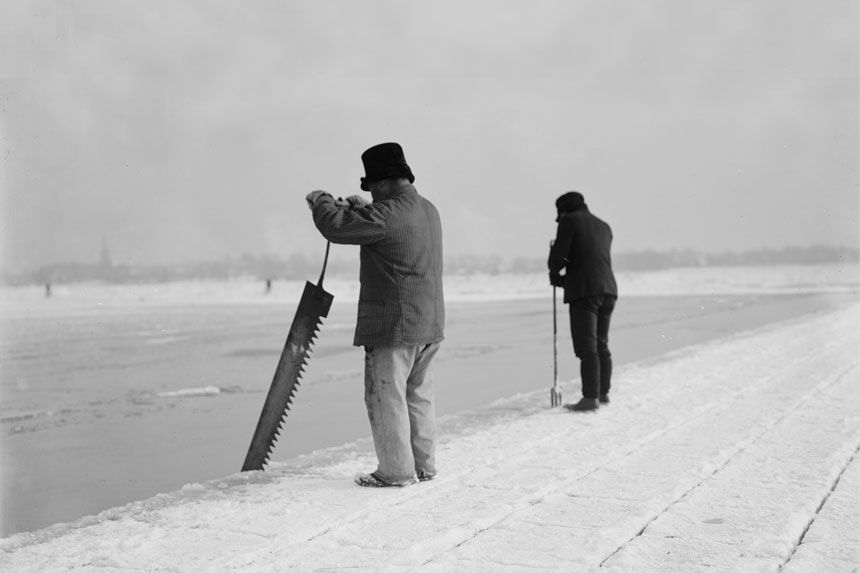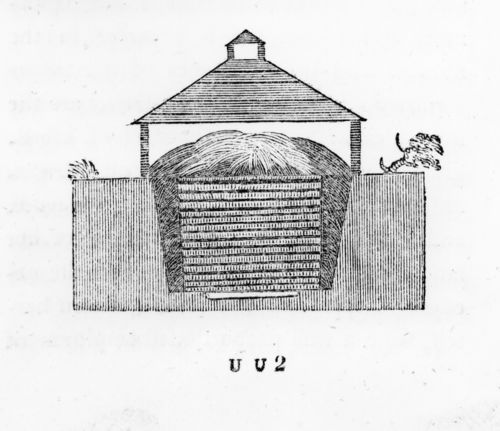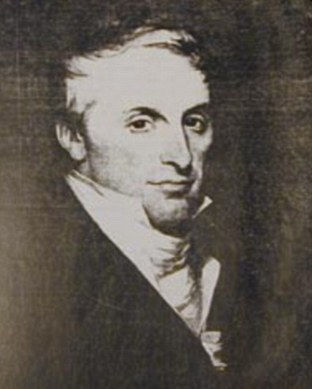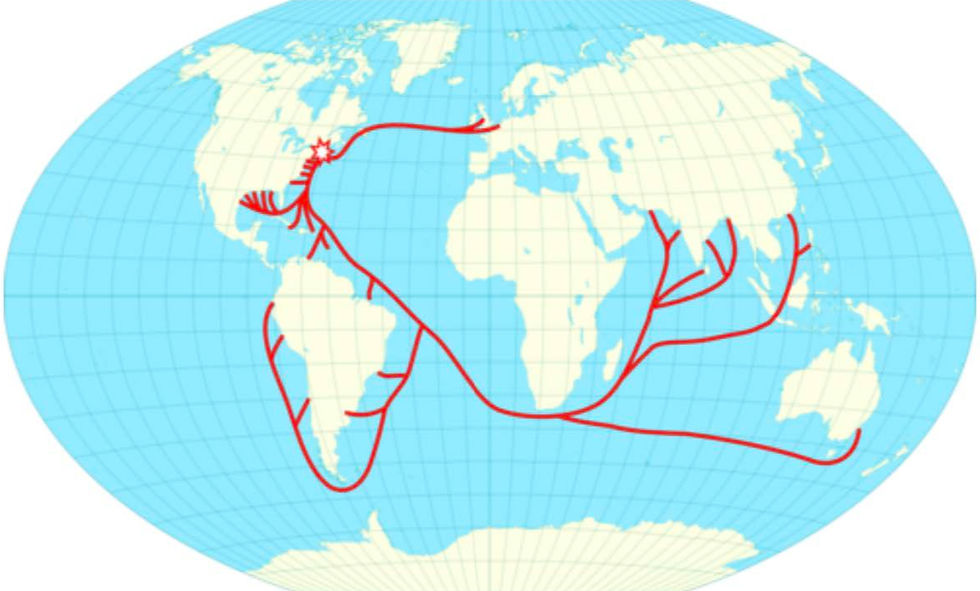A History of Ice in the Tropics
- Mark Dworkin
- Aug 7
- 8 min read
John F. McKeon

At the turn of the 19th century, at the age of 17, Frederic Tudor stood on the deck of a ship bound for the Caribbean. Coming from the power of old wealth and social standing, his father had financed his voyage. Suffering the heat and humidity of the tropics and dressed in the heavy attire emblematic of his class, a radical idea occurred to young Frederic. He pondered whether he could somehow transport ice from the frozen north to the West Indies? If he could, would there be a market for it? His idea seemed improbable if not impossible.(1)The 1obstacles facing Tudor seemed insurmountable. How would he go about it?
1. Note: Prior to the emergence of the 19th century ice trade, snow and ice had been collected and stored for the summer months in various parts of the world, but never on a large scale.In the Mediterranean and in South America, for example, there was a long history of collecting ice from the upper slopes of the Alps and the Andes during the summer months and transporting this down into the cities. Similar trading practices had grown up in Mexico during the colonial period. Tablets from the Bronze Age depict ice houses on the Euphrates River built for storing ice collected in winter.[4] The Russians collected ice during the winter months for consumption in Saint Petersburg . Europeans began to build ice houses to store ice on their local estates during the winter from the 16th century onwards.
Frederic’s First Attempt

Tudor proposed to export ice as a luxury item appealing to the wealthy planters of the West Indies as well as those in the southern US. He invested in a brigantine(2) called ‘The Favorite’ to transport the ice he had purchased from farmers surrounding the Boston area. The northeastern farmers historically had cut surface ice from the ponds and streams, then stored it in ice houses, before being sent on by ship, barge or railroad to its final destination.
Frederic convinced his brother William(3) to join him in his scheme to ship ice from New England to the Caribbean. Tudor reasoned that once people tried it, they would be sold on the idea, and could not live without it. In the following months, the brothers combined their resources and laid out plans to ship their product to the French island of Martinique, anticipating establishing an eventual monopoly on the ‘ice trade’
In November 1805, Tudor dispatched his brother William to Martinique as his advance man, and began harvesting ice in preparation.
2. A brigantine is a two-masted sailing vessel with a fully square-rigged foremast and at least two sails on the main mast: a square topsail and a gaff sail mainsail (behind the mast).
3. William Tudor would soon leave the partnership.
In February, the Favorite set sail from Boston Harbour, loaded with a full cargo of ice, bound for the West Indies. The ship’s departure was reported in the Boston Gazette which derisively questioned the sanity of the proposition. The Gazette would turn out to be accurate, though not for the reasons expected.
Despite weather related delays, the ice actually arrived in Martinique in amazingly good shape, unfortunately the residents of Martinique lacked any interest in his frozen cargo. They had no idea what to do with it. Tudor’s brother William failed in lining up an exclusive buyer for the cargo. Even worse, William had failed to establish a location to store the ice. The trip’s complete failure of the Martinique voyage would repeat itself in the years to come, with even worse results.(4) So, how did Tudor finally find success in 4 the Ice Trade?
Challenges and Solutions:
Initially, Tudor faced challenges in keeping the ice from melting, but his development of icehouses in the Danish West Indies, particularly St. Croix, and were primarily used for storing ice imported from colder climates, mainly for the preservation of food and beverages. These structures were essential for daily life and commercial operations in the absence of mechanical refrigeration.
4. For example when Tudor looked to expand his trade into Jamaica, his ship was wrecked along the way. The War of 1812 ensured that he was looking at another lost season of selling ice. The war did however bring out another ambition of Tudor’s, inventing, and instead of focusing on another lost season he designed a new kind of boat he believed would be useful in the war. Once built, the sixty-six foot long Black Swan made its maiden voyage up the Charles River on May 1st 1813 with Tudor on board.
Tudor though inventive and clever was savy enough to realize he needed help, actually quite a bit of help. In !825 Tudore smartly hired Nathaniel Jarvis Wyeth.(5) Wyeth 5who in his first winter as manager of the Fresh Pond Ice fields developed a horse-drawn ice cutter which allowed for the previously random uneven blocks of ice to be cut, and then stacked and stored, uniformly. This device reduced the cost of harvesting winter ice from thirty cents per ton to ten cents per ton. His invention increased efficiency and made both Tudor and Wyeth wealthy men.His experiments with insulating materials and new ice houses which decreased melting losses from 2/3rd to less than 10 percent. Wyeth made ice harvesting faster, storage more effective, and shipping easier, all the while reducing waste.Tudor’s startup business may have had a demand and a storage problem, but there were also some hidden advantages.
Ships tended to leave Boston harbor empty, heading off for the West Indies to fill their hulls with valuable cargo, He could negotiate cheaper rates for transporting his ice on the otherwise empty vessels. Better yet the ice itself was basically free. Tudor needed only to pay workers to carve blocks of it out of the frozen lakes. New England’s economy generated another product that was equally worthless. Sawdust – the primary waste product of lumber mills.This was Tudor’s ingenious gift. He took three things that the market had effectively priced at zero; ice, sawdust, and an empty ships and converted the three into a thriving business
5. Wyeth was born in 1802 and grew up learning the management of his father’s hotel. During the winters, the hotel’s off season, Wyeth worked for Frederick Tudor, stocking the ice houses with the ice from Fresh Pond and insulating it for travel with sawdust.
The Ice House (6)

Ice houses served as a critical method for preserving ice This allowed people to keep food and drinks cool during warmer months, long before the invention of refrigerators. Ice houses were typically built with thick walls and roofs, often partially buried to take advantage of the earth's insulating properties. They were frequently constructed from wood or brick and featured double walls with insulation like sawdust, wood shavings, or straw packed between the layers. Proper Insulation and drainage within the walls and the roof helped minimize heat transfer into the structure, slowing down the melting process. Drain holes were incorporated to allow meltwater to escape, preventing the ice from sitting in water and melting faster. The Caribbean's tropical climate made ice a highly sought-after commodity for keeping food fresh and beverages cold. Once the storage problem was solved Tudor was quick to develop infrastructure and eventually built special ice houses to receive and store the new commodity in the Caribbean. Before the widespread availability of modern refrigeration, imported ice provided a crucial way for the elite to enjoy luxuries like chilled drinks and preserve certain foods in the Caribbean's hot climate
6. Fig. 4, J. B. Bordley, “Section of an ice-pit,” in Richard Parkinson and J. B. Bordley, A Tour in America, 1798–1800, 2 vols., 2:699. Bordley cites this image as a “Section of an ice-pit, with its log-cell insulated with straw on all sides; and a house covering the whole.”
Going forward Tudor expanded his markets to include Cuba and the US. His monopolization of the ice trade did not survive.(7) Many other merchants competed with Tudor in harvesting and shipping ice from New England. However Tudor had made a fortune in India, while branding his product with names. Wenham Ice became famous in London.
The ice trade began to focus on supplying the growing cities on the east coast of the US, and the needs of businesses across the Midwest. New York City and Philadelphia became immense consumers of ice during their steamy summers, and the sorely needed ice was harvested from the Hudson River and Maine to fulfill the demand. Tudor had even attempted a failed try at harvesting Ice Bergs!(8)
Ice went on to be used by the railroad industry, allowing the meat packing industry around Chicago and Cincinnati to slaughter cattle locally, and send the butchered and prepared meat in chilled rail cars to US domestic and even international markets.
7. Learning from the debacle in Martinique ,Tudor built a functioning ice depot in Havana and, despite the US. trade embargo in 1807, was trading again by 1810. Though he was unable to acquire exclusive legal rights to import ice into Cuba, he was able to maintain an effective monopoly through his control of the ice houses.
8. Tudor looked to the only reliable source of ice that existed in the middle of summer: icebergs. A crew dispatched to cut pieces of the floating mountains. Led by a Captain Hadlock, the crew began their work of chipping it down before a violent storm forced them into hiding. Once clear of the uncooperative weather they began work on another iceberg but did not consider the necessity of cutting away at it evenly. causing the iceberg to become imbalanced and tip over slicing a massive hole in the ship. Miraculously, enough water was pumped out for the ship to stay afloat and actually made it to Martinique

The Business Man
Tudor’s business acumen allowed him to implement forward looking managerial practices. The accounting records of the Tudor Ice Company were devised to manage and control the far flung business activities of Frederic Tudor, who has been called America's first monopolist.
‘Tudor's business genius lay in developing methods of harvesting, transporting, storing, and marketing commercial quantities of ice taken from New England ponds and shipped to tropical ports aroun the world. Frederic Tudor employed relatively sophisticated accounting techniques to analyze and control transportation costs and the costs of product shrinkage. He also routinely analyzed and translated foreign currency transactions for his geographically dispersed operations and evaluated the impact of competition on his operations.(9)
By his death in 1864, after numerous financial setbacks, an internment in debtors prison and multiple failures Tudor had amassed a fortune worth more than $200m in current dollars. In New York two out of three homes received daily deliveries of ice. In less than a century, Tudor ( known as the ‘Ice King’ ) was the father of an industry that provided a product that was at first a curiosity, then a luxury, and finally a necessity.
9. PLANNING AND CONTROL IN THE 19th CENTURY ICE TRADE Linda H. Kistler; Clairmont P. Carter; Accounting Historians Journal (1984) 11 (1): 19– 30. https://doi.org/10.2308/0148-4184.11.1.19

The Danish West Indies were obviously never a major source of ice production or export in the ice trade, but they were a recipient of ice imports, particularly during the trade’s peak, illustrating the interconnectedness of global trade networks in the Atlantic World.
Decline and Legacy
The decline of the natural ice trade coupled with the rise of artificial refrigeration in the 20th century eventually rendered the natural ice trade obsolete, making long-distance ice shipments unnecessary.Yet the trade’s impact and legacy is that it created new industries and provided a previously unavailable luxury in tropical climates, significantly impacting the way people lived and enjoyed cold refreshments. The ice trade ultimately declined with the advent of refrigeration technology in the twentieth century. Refrigerators becoming increasingly common in homes and businesses. With the advent of electric refrigerators and freezers, the need for ice houses gradually diminished. However, they remain interesting examples of early refrigeration technology and are sometimes preserved as historical landmarks



